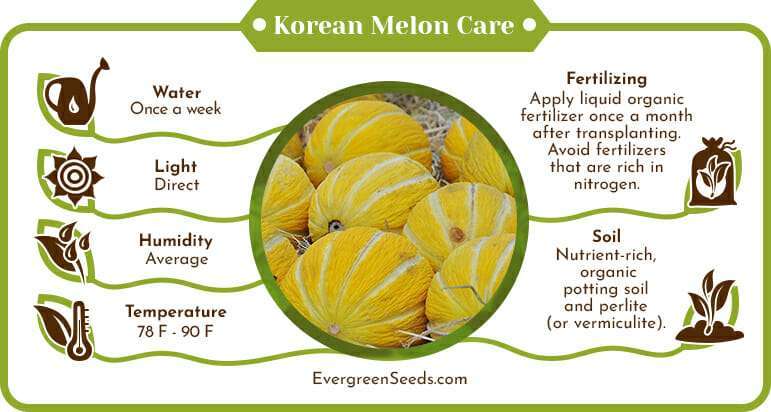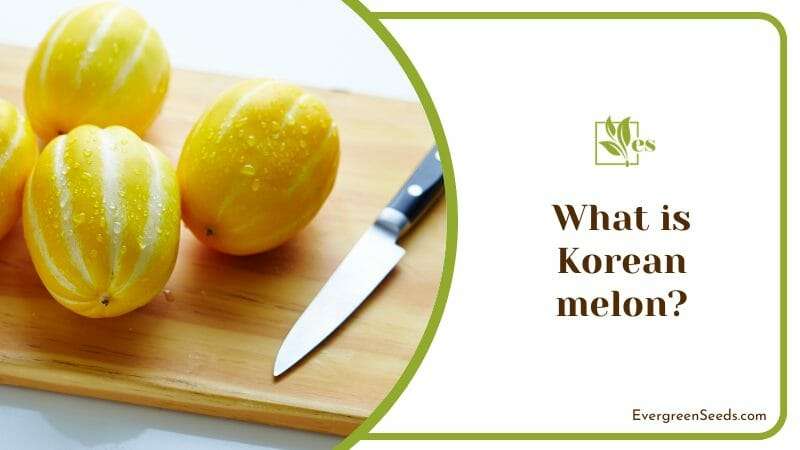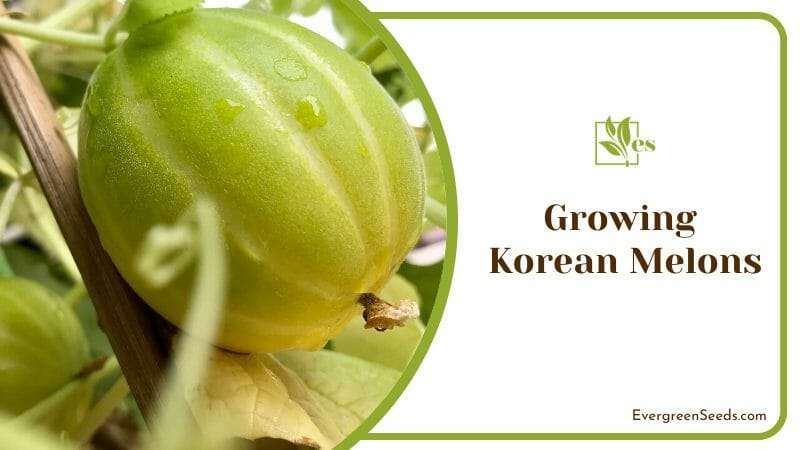- When to Plant Zucchini in Maryland: Optimal Times for Success - June 27, 2024
- When to Plant Grass Seed in Austin TX: Best Seasons and Techniques - June 27, 2024
- When to Plant Butternut Squash in NC: Best Times and Tips for Success - June 27, 2024
 Korean melon from the Cucumis melo group, also known as oriental melon, is a type of fruiting vine widely grown in Asia and closely related to muskmelon.
Korean melon from the Cucumis melo group, also known as oriental melon, is a type of fruiting vine widely grown in Asia and closely related to muskmelon.
It’s deliciously sweet, and among the tastiest Asian fruits you can grow. Difficult to find fresh in the store, it’s much better to grow your own at home.
In this guide, we’ll show you how it’s done!
JUMP TO TOPIC
What is Korean melon?
Sometimes called Korean sweet melon, or Korean yellow melon, the Korean melon produces oblong, yellow fruit about a papaya’s size, with a unique fragrance and aroma and a juicy sweetness.
 You will find several varieties of oriental melon on the market, but the most popular one is called euncheon-chamoe in Korean, or ginsen makuwa in Japan. This variety is instantly recognizable due to its golden fruit, cream stripes on the rind, small, edible seeds, and intense flavor.
You will find several varieties of oriental melon on the market, but the most popular one is called euncheon-chamoe in Korean, or ginsen makuwa in Japan. This variety is instantly recognizable due to its golden fruit, cream stripes on the rind, small, edible seeds, and intense flavor.
On top of this, you will also find various hybrids that come in different shapes and sizes, some round, some green, and some that have ridges on the rind. All of them produce sweet fruit and require the same type of growing conditions.
How to grow Korean melon
Growing Korean melons can be very easy if you keep the following 3 tips in mind:
- Korean melons typically need a long and warm growing season;
- They are vining plants and will need a trellis or other support system;
- Pollination is crucial to produce fruit.
With that in mind, let’s take a look at how you can grow Korean melons in your garden.
1. Growing Korean melon outdoors
Korean melon seeds are much smaller than other melon varieties and don’t require soaking before sowing. True, soaking for a couple of hours can help them germinate faster, but given that the seeds will sprout in a few days, that won’t be necessary.
– Germination
Our recommendation is to germinate the seeds indoors in compostable seed pots to get a head start in your Korean melon crop. A pot that is around 3 inches (8 cm) tall will work nicely. Fill each pot with a loose compost or potting mix, make a small dip in the middle, and place one seed per pot. Cover the seed with a thin layer of soil, and use a spray pump to water gently, keeping the soil moist but not soaked.
Korean melon seeds need warm temperatures to germinate, so aim for a range between 78°F and 90 °F (25 °C to 32 °C). On average, you should start seeing the seedlings 3 days after sowing or after 10 days if the pots are kept in a cooler room. Once each plant has 2 – 3 sets of leaves, they are ready to be transplanted to your garden.
 Temperature and soil
Temperature and soil
The best time to grow Korean melons outdoors is in late spring, or when the soil temperature is consistently above 78 °F (25 °C). The plants need very rich soil for healthy growth, so prepare a soil substrate that incorporates compost or manure, which is well-draining. Aim for a soil pH ranging from 6.0 to 6.8 ensures that the young plants can adequately absorb the nutrients they need.
– Location
Korean melon plants love the sun and will grow best when planted in direct light. Try to find a part of your garden where they can get at least 6 hours of sun per day. These melons need a minimum of 50 warm days per year for an abundant harvest or climates where summers last at least 3 months.
– Support and spacing
Before transplanting your seedlings to the soil, make sure that you have some support system in place. Although Korean melon doesn’t grow as tall as other melons, it loves to climb. A trellis is essential in providing space for the fruit to grow and ensuring air circulation, which prevents pests and fungal diseases from attacking the plants.
Set up a trellis or a support system around 1 foot (30 cm) tall and at least twice as wide. As the plants grow, you can trail them by hand to encourage them to vine horizontally. Transplant your Korean melon seedlings to the soil by planting them 2 feet (60 cm) apart, in rows that are at least 3 feet (90 cm) apart.
 Watering
Watering
Water well to a depth of at least 2 inches (5 cm) after transplanting. As the plants settle, you can reduce the amount of watering to once a week. Always water your Korean melon plants at the bottom, and avoid splashing water on the leaves and fruit, as this will lead to fungal diseases later on. Adding a layer of mulch to the plants’ base is also recommended, which will significantly help retain soil moisture.
One of the critical tips to growing Korean honey melon that is sweet and juicy is to stop watering them as the fruit has grown to full size, but it hasn’t ripened yet. At this stage, irrigating your plants will result in melons that are bland and watery in taste. Only water your melons if you see clear signs that the plants need it, such as leaves starting to become soft and slightly droopy.
 Fertilizer
Fertilizer
Apply liquid organic fertilizer once a month after transplanting your Korean melons to the soil type you picked. Fish emulsion is the right choice, or you can go for a nutrient ratio of 2-3-1. In general, it’s best to avoid fertilizers that are rich in nitrogen, as this will stimulate leaf growth, and the plant will produce fewer flowers and fruit.
2. Growing Korean melon in containers
Unlike other varieties of gourds and melons, Korean melons are very well suited for container growth. Their fruit is usually lighter, the leaves are smaller and more compact, and they don’t take up as much space with their vines. You will still need to provide them with something to trail on, but they are fairly low maintenance and easy to grow in general.

Oriental melons vary in size depending on the hybrid. Some can weigh as little as 10 oz. (300 g), while others weigh in at a hefty 6.6 pounds (3 kg). If you want to grow Korean melons in containers, make sure to pick a dwarf variety or produce smaller, lighter fruit.
– Choosing the right pot and soil
Pick a large container with proper drainage holes at the bottom. A 10 gallon (38 liter) pot will work nicely. Fill the container with a mixture of nutrient-rich, organic potting soil and perlite (or vermiculite), which will help drainage and retain soil moisture.
– Germination
You can sow your Korean melon seeds directly in the container. However, we recommend starting them off in compostable seed pots. This way, you will know precisely how many plants have germinated successfully. You can group two plants per container to save space, especially if they’re dwarf varieties. Make sure to build a support system and use either trellis, netting, or even clotheslines.
– Watering potted Korean melon
Once they are transplanted to the container, your Korean melon plants need the same growing conditions as those planted in the garden. The main thing to pay attention to is watering.
The soil in containers tends to dry out much quicker than soil in the garden, so your melons will need to be watered more frequently. However, avoid overwatering because this can damage the roots and lead to rot and other fungal problems. Check the soil with your finger, and only water when the top inch (2.5 cm) feels dry to the touch.
– Pollination
Container-grown Korean melons will also need to be manually pollinated to produce fruit. This is especially important if you are growing them indoors, in an urban area, or in a place that’s unlikely to be visited by pollinators such as bees and butterflies. Manual pollination is a lot easier than you’d think — read on to see how it works.
3. How to pollinate Korean melon
Korean melon will start producing small, yellow flowers a few weeks after being transplanted to the soil. Like other melons and gourds, it produces separate male and female flowers, and the male ones are the first to appear on the vine. You can quickly tell them apart by looking at the stem: female flowers have a small lump right under the petals, which will grow into the melon fruit after pollination.

Although insects typically pollinate Korean melon flowers, manual pollination is highly encouraged. This is one trick you can use on all types of melons, and it will significantly increase your chances of harvesting fruit later on. If you’re growing melons in containers, indoors, or in a greenhouse, manual pollination is necessary.
To pollinate Korean melons, snip off the male flower from the vine, gently rub it on the female flower, and transfer the pollen on the pistil. The best time to do this is in the afternoon when both flowers have their petals open wide. If pollination is successful, the small bulb on the female flower stem will grow in size, and the flower itself will dry and fall off after a few days.
Don’t overdo it!
On average, it’s best to grow around 4 to 5 melons per plant.
This way, the weight won’t damage the vines, and the plant won’t be stressed by trying to provide water and nutrients to the fruiting bodies and the leaves. Once you have about 5 baby melons taking shape on each plant, you can snip off the other female flowers.
4. When to harvest Korean melon
Korean melons reach maturity as early as 70 days after sowing, although some hybrids can take as long as 100 days. The fruit usually ripens within 40 days after pollination.
Knowing the right time to harvest Korean melons can be tricky, and it’s a skill you will develop in time.
There are a few tricks you can use to tell whether the melons are ripe:
- Tap the melon: it should produce a hollow sound;
- Smell: ripe Korean melons have a distinctive aroma even when they’re on the vine, while the unripe ones won’t smell like much;
- Check the stem: ripe melons have a dried stem that looks a bit shrunk, and there is usually a crack where the stem attaches to the fruit;
- Color: when ripe, Korean melons have a vivid yellow color, with light cream stripes running along its length; unripe melons are also bright yellow, so make sure to check the stem, the smell, and the sound of the melon makes before picking.
5. How to harvest Korean Melon
To harvest Korean melons, use a pair of gardening scissors to cut the stem. If the fruit falls quickly off the vine, that’s usually a sign that the melons are too ripe. Korean melons don’t continue to ripen after they have been harvested. Instead, they only become softer, so time your harvest right to enjoy the fruit when it’s sweet and fragrant.
After harvesting, Korean melons can be stored in the vegetable drawer of your fridge for up to a week. The fruit is small enough to store whole, but sliced melons can be kept in the refrigerator for up to 3 days, covered in plastic wrap.
Uses for Korean melon
Korean melon is one of the most delicious Asian fruits you will come across. The ripe fruit has a white or light-cream colored flesh that is juicy, sweet, and intensely fragrant. The taste is uniquely delicate and can be compared to a mix between honeydew melon, Bartlett pear, and a touch of ripe banana.

Not only are Korean melons moreish and delicious, but they are also very healthy, packed full of vitamins A and C, fiber, and minerals such as calcium and iron. They’re also 90% water, making them excellent thirst-quenchers.
The best way to enjoy Korean melon is by eating it raw. Chill for a few hours, peel off the thin rind, and serve. The small seeds are also edible, but depending on your preference, you can scoop them out. Korean melon is sweet enough to be a dessert in its own right, although it can also be used in smoothies, ice cream, cakes, or cut into cubes and used in fruit salads.












